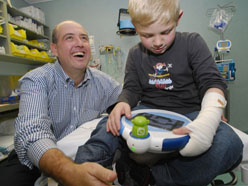Cunningly disguised as a toy, a new medical device that harnesses the power of distraction can greatly reduce the pain felt by young burns victims.
Designed for medical device company Diversionary Therapy Technologies by Sam Bucolo, who is a Queensland University of Technology industrial design Associate Professor, Ditto is a virtual reality-inspired diversionary therapy aid. Professor Bucolo said that the trademarked Ditto device is able to distract a child’s attention to help them through the painful process of having burns dressings changed, which a patient may endure several times before recovery.
Professor Bucolo said Ditto was undergoing clinical trials to recognise it as a fully-fledged medical device, and it has been shown to be more effective at reducing pain scores than the traditional methods of distraction used in hospitals, such as videos and computer games.
“Burns patients need to have their bandages changed three times a week for up to two months, and this is a very painful experience,” Professor Bucolo said.
“The children are already anxious when they arrive at the hospital, because they know the procedure is going to hurt.
“However, we know that pain perception has a strong psychological component that can be overcome with appropriate preparation and distraction.”
Professor Bucolo said Ditto was designed for children aged three to eight years old and used multi-modal interaction a technology that was closely related to virtual reality, but did not require bulky equipment or goggles that might distress young, anxious children.
“It was important that the product took only seconds to engage the child and it was also important that the distraction lasted 20 minutes, about the length of time it usually takes a nurse to replace burns bandaging,” Professor Bucolo said
“The child holds the circular Ditto device and tilts it to navigate through the virtual world, rather than using a keyboard or separate game controller.
“The whole form of the toy is the interface. It has a touch screen and vibrating handles.
“Children can choose a character who accompanies them through the games, ‘find and touch’ stories and sing-along movies. They can also take a figurine of their character home with them.”
Professor Bucolo said the virtual world could be seen from all angles simply by moving the toy.
“They can even look underneath objects by tipping it upside-down,” he said.
Ditto won for Diversionary Therapy Technologies the Australian leg of the UK-based business competition Technium Challenge International.
The project originated at the Australasian CRC for Interaction Design, based at QUT, and involved a range of researchers including doctors, designers, children’s authors and engineers.
Funding was received from the Queensland Department of State Development, a Federal Government Commercial Ready grant and private funding.
Ditto is due to be commercially available at the end of this year.
 Source: Queensland University of Technology

